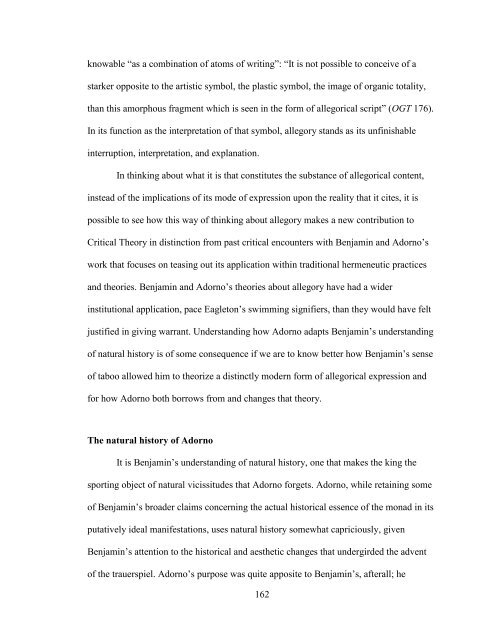TABOO: THE ACTUAL MODERNIST AESTHETIC, MADE REAL A ...
TABOO: THE ACTUAL MODERNIST AESTHETIC, MADE REAL A ...
TABOO: THE ACTUAL MODERNIST AESTHETIC, MADE REAL A ...
Create successful ePaper yourself
Turn your PDF publications into a flip-book with our unique Google optimized e-Paper software.
knowable “as a combination of atoms of writing”: “It is not possible to conceive of a<br />
starker opposite to the artistic symbol, the plastic symbol, the image of organic totality,<br />
than this amorphous fragment which is seen in the form of allegorical script” (OGT 176).<br />
In its function as the interpretation of that symbol, allegory stands as its unfinishable<br />
interruption, interpretation, and explanation.<br />
In thinking about what it is that constitutes the substance of allegorical content,<br />
instead of the implications of its mode of expression upon the reality that it cites, it is<br />
possible to see how this way of thinking about allegory makes a new contribution to<br />
Critical Theory in distinction from past critical encounters with Benjamin and Adorno‟s<br />
work that focuses on teasing out its application within traditional hermeneutic practices<br />
and theories. Benjamin and Adorno‟s theories about allegory have had a wider<br />
institutional application, pace Eagleton‟s swimming signifiers, than they would have felt<br />
justified in giving warrant. Understanding how Adorno adapts Benjamin‟s understanding<br />
of natural history is of some consequence if we are to know better how Benjamin‟s sense<br />
of taboo allowed him to theorize a distinctly modern form of allegorical expression and<br />
for how Adorno both borrows from and changes that theory.<br />
The natural history of Adorno<br />
It is Benjamin‘s understanding of natural history, one that makes the king the<br />
sporting object of natural vicissitudes that Adorno forgets. Adorno, while retaining some<br />
of Benjamin‘s broader claims concerning the actual historical essence of the monad in its<br />
putatively ideal manifestations, uses natural history somewhat capriciously, given<br />
Benjamin‘s attention to the historical and aesthetic changes that undergirded the advent<br />
of the trauerspiel. Adorno‘s purpose was quite apposite to Benjamin‘s, afterall; he<br />
162
















